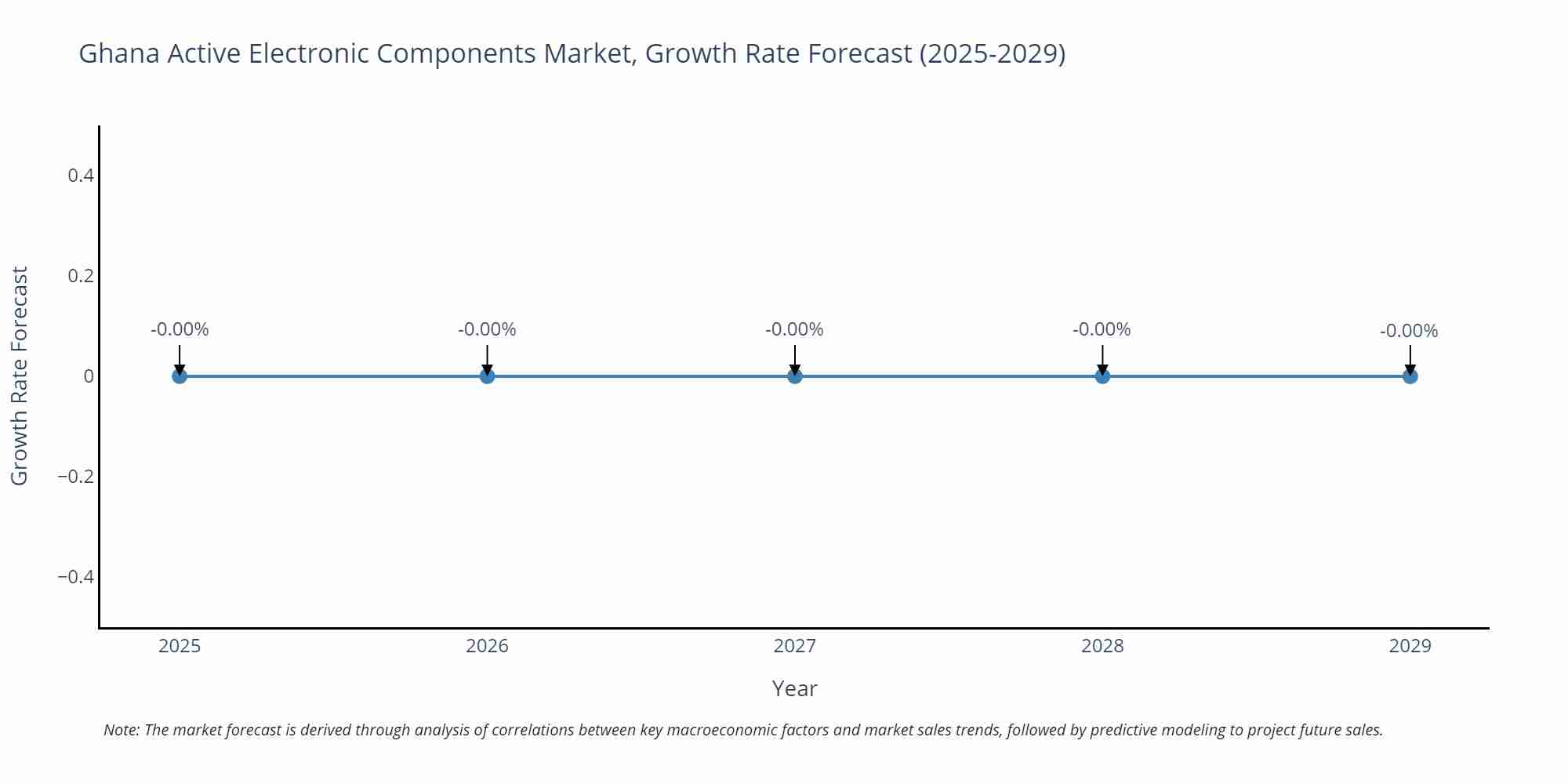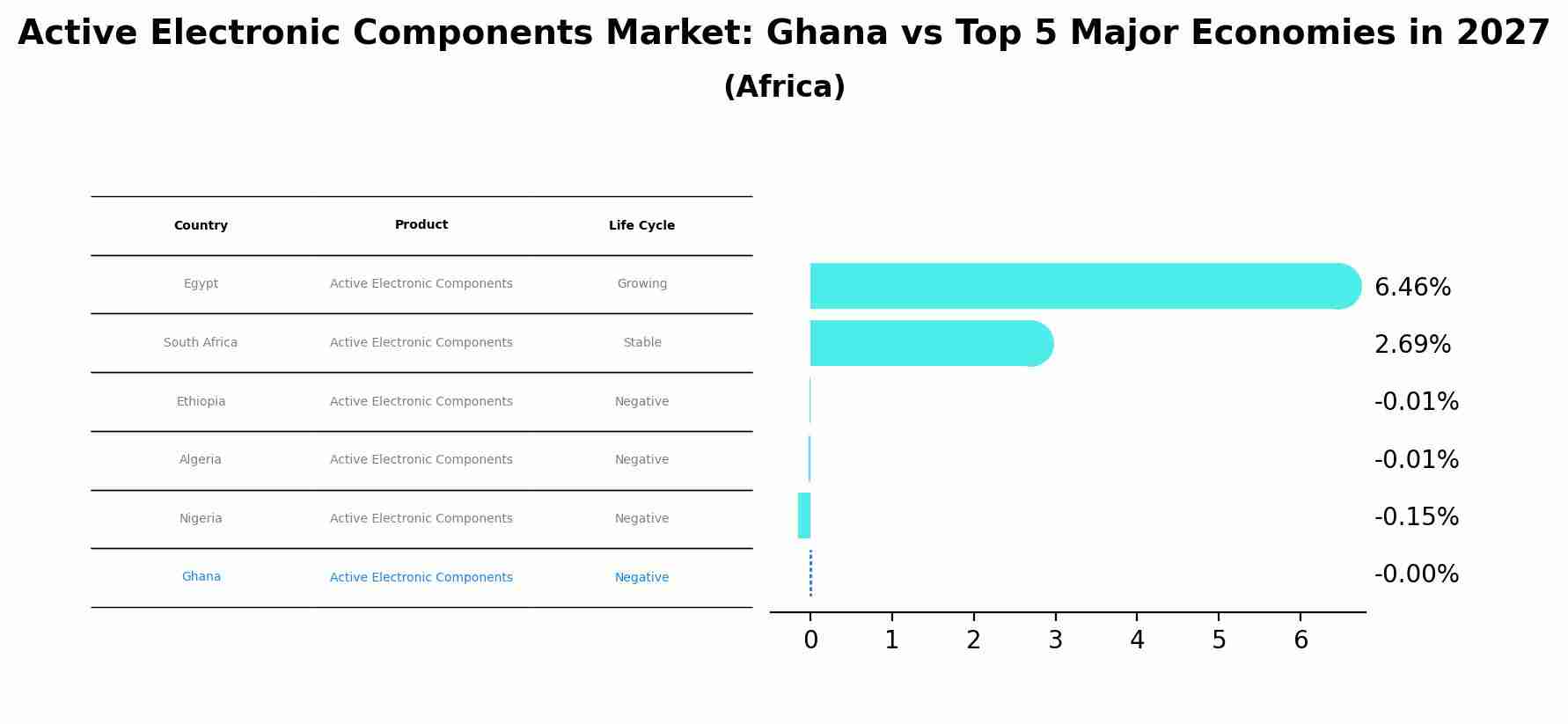Ghana Active Electronic Components Market (2025-2031) Outlook | Value, Forecast, Industry, Companies, Revenue, Analysis, Size, Trends, Growth & Share
| Product Code: ETC361436 | Publication Date: Aug 2022 | Updated Date: Jul 2025 | Product Type: Market Research Report | |
| Publisher: 6Wresearch | Author: Bhawna Singh | No. of Pages: 75 | No. of Figures: 35 | No. of Tables: 20 |
Ghana Active Electronic Components Market Size Growth Rate
The Ghana Active Electronic Components Market may undergo a gradual slowdown in growth rates between 2025 and 2029. Although the growth rate starts strong at -0.00% in 2025, it steadily loses momentum, ending at -0.00% by 2029.

Active Electronic Components Market: Ghana vs Top 5 Major Economies in 2027 (Africa)
The Active Electronic Components market in Ghana is projected to grow at a negative growth rate of -0.00% by 2027, highlighting the country's increasing focus on advanced technologies within the Africa region, where Egypt holds the dominant position, followed closely by South Africa, Ethiopia, Algeria and Nigeria, shaping overall regional demand.

Ghana Active Electronic Components Market Synopsis
The Ghana Active Electronic Components Market is experiencing steady growth driven by increasing demand for electronic devices in sectors such as telecommunications, automotive, and consumer electronics. The market is characterized by a wide range of active components such as transistors, diodes, integrated circuits, and sensors. Key factors contributing to market growth include technological advancements, rising disposable incomes, and government initiatives to promote the electronics industry. However, challenges such as counterfeit products and fluctuating raw material prices are impacting market dynamics. Major players in the Ghana Active Electronic Components Market include international companies as well as local manufacturers, focusing on product innovation and strategic partnerships to gain a competitive edge in the market.
Ghana Active Electronic Components Market Trends
In the Ghana Active Electronic Components Market, there is a noticeable trend towards miniaturization and increased functionality of electronic components. With the growing demand for smaller and more powerful electronic devices, manufacturers are focusing on developing active components that are compact yet offer high performance. Another significant trend is the shift towards energy-efficient components as sustainability becomes a key consideration for consumers and businesses alike. Additionally, the market is seeing a rise in the adoption of advanced technologies such as Internet of Things (IoT) and artificial intelligence, driving the demand for active components that can support these applications. Overall, there is a drive towards innovation and technological advancements in the Ghana Active Electronic Components Market to meet the evolving needs of the industry and consumers.
Ghana Active Electronic Components Market Challenges
In the Ghana Active Electronic Components Market, some challenges include limited access to advanced technology and high-quality components, which can hinder the development of innovative products. Additionally, fluctuating exchange rates and import duties on electronic components can impact pricing and profitability for local manufacturers and distributors. The lack of a robust local manufacturing base for active electronic components also leads to a heavy reliance on imports, making the market vulnerable to supply chain disruptions and global economic fluctuations. Furthermore, the presence of counterfeit components in the market poses a threat to product quality and reliability, potentially damaging the reputation of businesses operating in the sector. Overall, navigating these challenges requires strategic partnerships, investment in technology, and a strong focus on quality control and compliance.
Ghana Active Electronic Components Market Investment Opportunities
The Ghana Active Electronic Components Market offers promising investment opportunities due to the country`s growing electronics industry and increasing demand for electronic devices. Potential investment avenues include manufacturing and distribution of active electronic components such as integrated circuits, transistors, and diodes. With the advancement of technology and the rising adoption of smart devices in Ghana, there is a need for high-quality electronic components to support this trend. Investing in the Ghana Active Electronic Components Market can provide long-term growth potential, especially with the government`s initiatives to promote the local electronics industry. Additionally, partnerships with local electronics manufacturers and distributors can further enhance market penetration and profitability in this sector.
Jordan Agar Market Government Policies
The Ghanaian government has implemented policies to promote the growth of the Active Electronic Components Market, such as providing tax incentives for local production and assembly of electronic components, supporting research and development initiatives in the sector, and encouraging partnerships between local companies and international manufacturers. Additionally, the government has focused on improving infrastructure and access to reliable electricity to facilitate the expansion of the electronics industry. These policies aim to attract foreign investment, create job opportunities, and enhance the competitiveness of Ghana`s electronics sector in the global market. Overall, the government`s initiatives demonstrate a commitment to fostering innovation, technology transfer, and sustainable growth in the Active Electronic Components Market in Ghana.
Ghana Active Electronic Components Market Future Outlook
The future outlook for the Ghana Active Electronic Components Market looks promising with a steady growth trajectory anticipated in the coming years. Factors driving this growth include the increasing adoption of advanced technologies in various industries such as electronics, automotive, and telecommunications, as well as the growing demand for energy-efficient electronic devices. Additionally, the government`s initiatives to promote the manufacturing sector and the rising investments in infrastructure development are expected to further fuel the demand for active electronic components in Ghana. With a focus on innovation, quality, and sustainability, manufacturers in the country are well-positioned to capitalize on these opportunities and contribute to the overall growth of the market.
Key Highlights of the Report:
- Ghana Active Electronic Components Market Outlook
- Market Size of Ghana Active Electronic Components Market, 2024
- Forecast of Ghana Active Electronic Components Market, 2031
- Historical Data and Forecast of Ghana Active Electronic Components Revenues & Volume for the Period 2021 - 2031
- Ghana Active Electronic Components Market Trend Evolution
- Ghana Active Electronic Components Market Drivers and Challenges
- Ghana Active Electronic Components Price Trends
- Ghana Active Electronic Components Porter's Five Forces
- Ghana Active Electronic Components Industry Life Cycle
- Historical Data and Forecast of Ghana Active Electronic Components Market Revenues & Volume By Product for the Period 2021 - 2031
- Historical Data and Forecast of Ghana Active Electronic Components Market Revenues & Volume By Semiconductor Devices for the Period 2021 - 2031
- Historical Data and Forecast of Ghana Active Electronic Components Market Revenues & Volume By Vacuum Tubes for the Period 2021 - 2031
- Historical Data and Forecast of Ghana Active Electronic Components Market Revenues & Volume By Display Devices for the Period 2021 - 2031
- Historical Data and Forecast of Ghana Active Electronic Components Market Revenues & Volume By Others for the Period 2021 - 2031
- Historical Data and Forecast of Ghana Active Electronic Components Market Revenues & Volume By End-user for the Period 2021 - 2031
- Historical Data and Forecast of Ghana Active Electronic Components Market Revenues & Volume By Consumer Electronics for the Period 2021 - 2031
- Historical Data and Forecast of Ghana Active Electronic Components Market Revenues & Volume By Networking & Telecommunication for the Period 2021 - 2031
- Historical Data and Forecast of Ghana Active Electronic Components Market Revenues & Volume By Automotive for the Period 2021 - 2031
- Historical Data and Forecast of Ghana Active Electronic Components Market Revenues & Volume By Manufacturing for the Period 2021 - 2031
- Historical Data and Forecast of Ghana Active Electronic Components Market Revenues & Volume By Aerospace & Defense for the Period 2021 - 2031
- Historical Data and Forecast of Ghana Active Electronic Components Market Revenues & Volume By Healthcare for the Period 2021 - 2031
- Historical Data and Forecast of Ghana Active Electronic Components Market Revenues & Volume By Others for the Period 2021 - 2031
- Ghana Active Electronic Components Import Export Trade Statistics
- Market Opportunity Assessment By Product
- Market Opportunity Assessment By End-user
- Ghana Active Electronic Components Top Companies Market Share
- Ghana Active Electronic Components Competitive Benchmarking By Technical and Operational Parameters
- Ghana Active Electronic Components Company Profiles
- Ghana Active Electronic Components Key Strategic Recommendations
Frequently Asked Questions About the Market Study (FAQs):
- Single User License$ 1,995
- Department License$ 2,400
- Site License$ 3,120
- Global License$ 3,795
Search
Related Reports
- Portugal Electronic Document Management Market (2025-2031) | Strategy, Consumer Insights, Analysis, Investment Trends, Opportunities, Growth, Size, Share, Industry, Revenue, Segments, Value, Segmentation, Supply, Forecast, Restraints, Outlook, Competition, Drivers, Trends, Demand, Pricing Analysis, Competitive, Strategic Insights, Companies, Challenges
- France Electronic Document Management Market (2025-2031) | Strategy, Consumer Insights, Analysis, Investment Trends, Opportunities, Growth, Size, Share, Industry, Revenue, Segments, Value, Segmentation, Supply, Forecast, Restraints, Outlook, Competition, Drivers, Trends, Demand, Pricing Analysis, Competitive, Strategic Insights, Companies, Challenges
- Portugal Occupational Health & Safety Services Market (2025-2031) | Strategy, Consumer Insights, Analysis, Investment Trends, Opportunities, Growth, Size, Share, Industry, Revenue, Segments, Value, Segmentation, Supply, Forecast, Restraints, Outlook, Competition, Drivers, Trends, Demand, Pricing Analysis, Competitive, Strategic Insights, Companies, Challenges
- Netherlands Occupational Health and Safety Services Market (2025-2031) | Strategy, Consumer Insights, Analysis, Investment Trends, Opportunities, Growth, Size, Share, Industry, Revenue, Segments, Value, Segmentation, Supply, Forecast, Restraints, Outlook, Competition, Drivers, Trends, Demand, Pricing Analysis, Competitive, Strategic Insights, Companies, Challenges
- Belgium and Luxembourg Facility Management Market (2025-2031) | Strategy, Consumer Insights, Analysis, Investment Trends, Opportunities, Growth, Size, Share, Industry, Revenue, Segments, Value, Segmentation, Supply, Forecast, Restraints, Outlook, Competition, Drivers, Trends, Demand, Pricing Analysis, Competitive, Strategic Insights, Companies, Challenges
- Russia Women Intimate Apparel Market (2025-2031) | Strategy, Consumer Insights, Analysis, Investment Trends, Opportunities, Growth, Size, Share, Industry, Revenue, Segments, Value, Segmentation, Supply, Forecast, Restraints, Outlook, Competition, Drivers, Trends, Demand, Pricing Analysis, Competitive, Strategic Insights, Companies, Challenges
- Africa Chocolate Market (2025-2031) | Size, Share, Trends, Growth, Revenue, Analysis, Forecast, industry & Outlook
- Global Hydroxychloroquine And Chloroquine Market (2025-2031) | Industry, Trends, Size, Outlook, Growth, Value, Companies, Revenue, Analysis, Share, Forecast
- Saudi Arabia Plant Maintenance Market (2025-2031) | Industry, Size, Growth, Revenue, Value, Companies, Forecast, Analysis, Share & Trends
- Taiwan Electric Truck Market (2025-2031) | Outlook, Industry, Revenue, Size, Forecast, Growth, Analysis, Share, Companies, Value & Trends
Industry Events and Analyst Meet
Our Clients
Whitepaper
- Middle East & Africa Commercial Security Market Click here to view more.
- Middle East & Africa Fire Safety Systems & Equipment Market Click here to view more.
- GCC Drone Market Click here to view more.
- Middle East Lighting Fixture Market Click here to view more.
- GCC Physical & Perimeter Security Market Click here to view more.
6WResearch In News
- Doha a strategic location for EV manufacturing hub: IPA Qatar
- Demand for luxury TVs surging in the GCC, says Samsung
- Empowering Growth: The Thriving Journey of Bangladesh’s Cable Industry
- Demand for luxury TVs surging in the GCC, says Samsung
- Video call with a traditional healer? Once unthinkable, it’s now common in South Africa
- Intelligent Buildings To Smooth GCC’s Path To Net Zero













